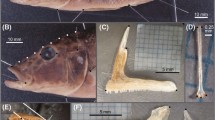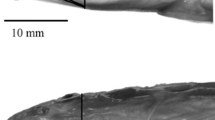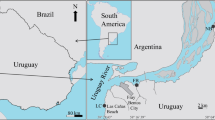Summary
The feeding performance on soft and hard prey of two morphs of the trophically polymorphic Neotropical cichlid fish, Cichlasoma citrinellum, was investigated in the laboratory. The molariform morphs, specialized to feed on hard prey, are able to crack snail shells that are twice as hard as those cracked by the papilliform morphs. During ecological bottlenecks in food resources this ability should allow molariform morphs to exploit alternate, less preferred prey sources that are not available to papilliform morphs. Analysis of stomach contents revealed that molariform morphs feed significantly more often on hard snails than do papilliform morphs (Meyer 1989a). The performance advantage of the trophically specialized morphs when feeding on hard prey is countered by their less efficient performance on soft diets. The morphologically generalized papilliform morph feeds more efficiently on soft prey. The abundance of preferred soft prey, seasonal fluctuations in prey availability and the frequency of ecological bottlenecks may determine the relative abundance of these two morphs in natural populations in Nicaraguan lakes.
Similar content being viewed by others
References
Arnold SJ (1983) Morphology, performance, and fitness. Am Zool 23:347–361
Barel CDN (1983) Towards a constructional morphology of cichlid fishes (Teleostei, Perciformes). Neth J Zool 3:357–424
Ehlinger TJ, Wilson DS (1988) Complex foraging polymorphism in the bluegill sunfish. Proc Natl Acad Sci USA 85:1878–1882
Galis F, de Jong PW (1988) Optimal foraging and ontogeny; food selection by Haploplochromis piceatus. Oecologia 75:175–184
Gatz JA Jr (1979) Community organization in fishes as indicated by morphological features. Ecology 60:711–718
Grant PR (1986) Ecology and evolution of Darwin's Finches. Princeton University Press, Princeton
Greenwood PH (1965) Environmental effects on the pharyngeal mill of a cichlid fish, Astatoreochromis alluaudi and their taxonomic implications. Proc Linn Soc Lond 176:1–10
Hart PJB (1986) Foraging in teleost fishes. In: Pitcher TJ (ed) The behaviour of teleost fishes. Croom Helm, London, pp 211–236
Hoogerhoud RJC (1984) A taxonomic reconsideration of the haplochromine genera Gaurochromis Greenwood, 1980 and Labidochromis Regan, 1920 (Pisces, Cichlidae). Neth J Zool 34:539–565
Hoogerhoud RJC (1986a) Ecological morphology of some cichlid fishes. Ph.D. thesis, Leiden, The Netherlands
Hoogerhoud RJC (1986b) Taxonomic and ecological aspects of morphological plasticity in molluscivorous Haplochromines (Pisces, Cichlidae). Ann Mus Roy Afr Centr Sc Zool 251:131–134
Hoogerhoud RJC, Barel CDN (1978) Integrated morphological adaptation in piscivorous and mollusc-crushing Haplochromis species. Osse JWN (ed) Adaptation. Proc Zodiac Symp on Adaptation. Wageningen, The Netherlands, pp 52–56
Hoogerhoud RJC, Witte F, Barel CDN (1983) The ecological differentiation of two closely resembling Haplochromis species from Lake Victoria (H. iris and H. hiatus; Pisces, Cichlidae). Neth J Zool 33:283–305
Katunzi EFB (1983) Seasonal variation in the food of a molluscivorous cichlid Haplichromis sauvagei Pfeffer 1896. Neth J Zool 34:337–342
Kaufman LS, Liem KF (1982) Fishes of the suborder Labroidei (Pisces: Perciformes): Phylogeny, ecology and evolutionary significance. Breviora 472:1–19
Keast A, Webb D (1966) Mouth and body form relative to feeding ecology in the fish fauna of a small lake, Lake Opinicon, Ontario. J Fish Res Bd Can 23:1845–1874
Kornfield IL, Smith DC, Gagnon PS, Taylor JN (1982) The cichlid fish of Cuatro Cienegas Mexico: direct evidence of conspecificity among distinct trophic morphs. Evolution 36:658–664
Kornfield IL, Taylor JN (1983) A new species of polymorphic fish, Cichlasoma minckleyi from Cuatro Cienegas, Mexico (Teleostei: Cichlidae). Proc Biol Soc Wash 96:253–269
Liem KF (1973) Evolutionary strategies and morphological innovations: cichlid pharyngeal jaws. Syst Zool 22:425–441
Liem KF (1984) Functional versatility, speciation and niche overlap: Are fishes different? In: Meyers DG, Strickler JR (eds) Trophic Interactions within Aquatic Ecosystems. AAAS Selected Symposium 85, pp 269–305
Liem KF, Kaufman LS (1984) Intraspecific macroevolution: functional biology of the polymorphic cichlid species Cichlasoma minckleyi. In: Echelle AA, Kornfield I (eds) Evolution of Fish Species Flocks. Univ. Maine Press, Orono, pp 203–215
Liem KF, Osse JW (1975) Biological versatility, evolution, and food resource exploitation in African cichlids. Am Zool 15:427–454
McKaye KR, Marsch A (1983) Food switching by two specialized algae-scraping cichlid fishes in Lake Malawi, Africa. Oecologia 56:245–248
Meyer A (1987) Phenotypic plasticity and heterochrony in Cichlasoma managuense (Pisces, Cichlidae) and their implications for speciation in cichlid fishes. Evolution 41:1357–1369
Meyer A (1988) Plasticity in morphology and performance in the trophically polymorphic cichlid fish Cichlasoma citrinellum. Ph.D. thesis, University of California, Berkeley
Meyer A (1989a) Ecological and evolutionary aspects of a trophic polymorphism in the Neotropical cichlid Cichlasoma citrinellum (Pisces, Cichlidae). Biol J Linn Soc (in press)
Meyer A (1989b) Trophic polymorphism in cichlid fish: do they represent intermediate steps during sympatric speciation and explain their rapid adaptive radiation? In: Schroder JH (ed) New trends in ichthyology. Paul Parey, Berlin (in press)
Rosenzweig ML (1978) Competitive speciation. Biol J Linn Soc 10:275–289
Sage RD, Selander RK (1975) Trophic radiation through polymorphism in cichlid fishes. Proc Nat Acad Sci USA 72:4669–4673
Schoener TW (1971) Theory of feeding strategies. Ann Rev Ecol Syst 2:369–404
Schoener TW (1974) Resource partitioning in ecological communities. Science 185:27–39
Seger J (1985) Intraspecific competition as a cause of sympatric speciation. In: Greenwood PJ, Harvey PH, Slatkin M (eds) Evolution, Essays in Honour of John Maynard Smith. Cambridge Univ. Press, Cambridge, pp 43–53
Slootweg R (1987) Prey selection by molluscivorous cichlids foraging on a schistosomiasis vector snail, Biomphalaria glabrata. Oecologia 74:193–202
Smith DC (1982) Trophic ecology of the cichlid morphs of Cuatro Cienegas, Mexico. MS thesis, University of Maine, Orono
Smith TB (1987) Bill size polymorphism and intraspecific niche utilization in an African finch. Nature 329:717–719
Stein RA, Kitchell JF, Knezevic B (1975) Selective predation by carp (Cyprinus carpio L.) on benthic molluscs in Skadar Lake, Yugoslavia. J Fish Biol 1975:391–399
Stein RA, Gosse-Goodman C, Marschall EA (1984) Using time and energetic measures of cost in estimating prey value for fish predators. Ecology 65:702–715
Townsend CR, Winfield IJ (1984) The application of optimal foraging theory to feeding behaviour in fish. In: Tyler P, Calow P (eds) Fish energetics new perspectives. Croom Helm, London, pp 67–98
Van Oijen MJP (1982) Ecological differentiation among the piscivorous haplochromine cichlids of Lake Victoria (East Africa). Neth J Zool 32:336–362
Van Valen L (1965) Morphological variation and the width of the ecological niche. Am Nat 94:377–390
Wainwright PC (1987) Biomechanical limits to ecological performance: mollusc crushing by the Caribbean hogfish, Lachnolaimus maximus (Labridae). J Zool Lond 213:283–297
Wainwright PC (1988) Morphology and ecology: the functional basis of feeding constraints in Caribbean labrid fishes. Ecology 69:635–645
Werner EE (1974) The fish size, prey size, handling time relation in several sunfishes and some implications. J Fish Res Bd Can 31:1531–1536
Werner EE (1977) Species packing and niche complementarity in three sunfishes. Am Nat 111:553–578
Werner EE, Hall DJ (1988) Ontogenetic habitat shifts in bluegill: the foraging rate-predation risk trade-off. Ecology 69:1352–1366
Wiens JA (1977) On competition and variable environments. Am Sci 65:590–597
Author information
Authors and Affiliations
Rights and permissions
About this article
Cite this article
Meyer, A. Cost of morphological specialization: feeding performance of the two morphs in the trophically polymorphic cichlid fish, Cichlasoma citrinellum . Oecologia 80, 431–436 (1989). https://doi.org/10.1007/BF00379047
Received:
Issue Date:
DOI: https://doi.org/10.1007/BF00379047




